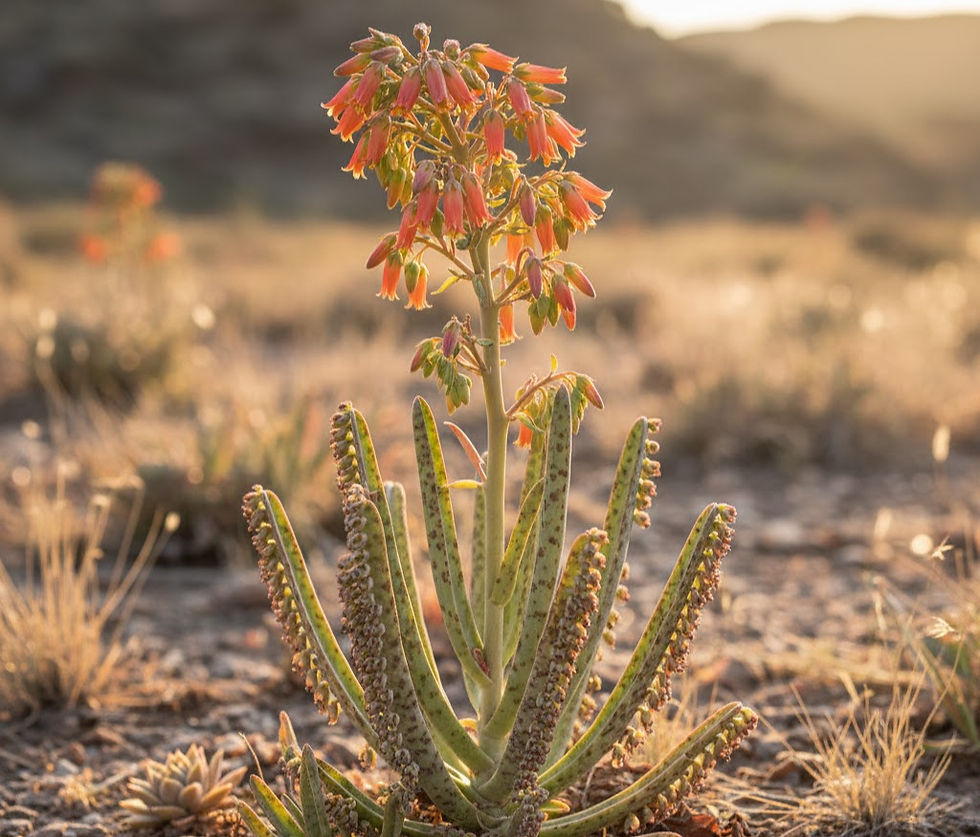Kalanchoe delagoensis(Crassulaceae) Chandelier Plant
- Das K

- Nov 9
- 3 min read
(Mother of Millions)

Taxonomic insights
Species: Kalanchoe delagoensis (Syn. Bryophyllum delagoense, Kalanchoe tubiflora)
Family: Crassulaceae
Genus: Kalanchoe
Related Herbs from the same family:Kalanchoe pinnata (Air Plant, Patharchatta) - A widely used Pan-Indian medicinal plant for kidney stones, wounds, and inflammation.Kalanchoe laciniata - Used similarly in traditional medicine for burns and inflammation. The genus Kalanchoe is known for its "viviparous" reproduction and significant medicinal uses in folk medicine across the world.
Common Names:Scientific Name: Kalanchoe delagoensis | English: Mother of Millions, Chandelier Plant | Sanskrit: Parnabija (a name often shared with K. pinnata) | Hindi: Zakhm-e-Hayat, Ghaayal | Tamil: Runakkalli, Malakkalli | Telugu: Simhadevadu | Kannada: Gandukalinga | Malayalam: Ilachevi, Elamulachi | Marathi: Panphuti |
Medicinal UsesAnti-inflammatory, Wound Healing, Analgesic (pain-relieving), Antiurolithiatic (Kidney Stone prevention), Antitumor, Antimicrobial, Astringent.
Phytochemicals specific to the plant and their action.
Bufadienolides: Bersaldegenin, Bryotoxins. These are cardiac glycosides and are the primary bioactive compounds. They possess significant Antitumor and Antimicrobial activities. WARNING: These compounds are highly toxic and can cause fatal cardiac poisoning if ingested in quantity.
Flavonoids: Quercetin, Kaempferol. These contribute to the plant's Antioxidant and Anti-inflammatory effects, which support its topical wound-healing properties.
Phenolic Acids and Tannins: These provide Astringent properties, helping to contract tissue and stop bleeding when applied topically.
Organic Acids: Like Isocitric acid. These may contribute to the plant's traditional use in preventing kidney stones by helping to dissolve calcium salts.
Traditional and Ethnobotanical uses covering the Medicinal uses.
Wound Healing & Anti-inflammatory (for Cuts, Burns, and Boils)
Formulation: Fresh leaf poultice or juice.
Preparation & Use: A few leaves are warmed and crushed to extract the mucilaginous juice, which is applied directly to wounds, burns, boils, and insect bites to promote healing and reduce pain and swelling.
Reasoning: The Astringent tannins help stop bleeding. The Anti-inflammatory flavonoids reduce swelling, and the overall biochemical mix may prevent infection, promoting faster tissue repair.
Analgesic (for Headaches and Earaches)
Formulation: Warm leaf juice.
Preparation & Use: A drop of the warm leaf juice is instilled into the ear for earaches. A cloth soaked in the warm juice is applied to the forehead for headaches.
Reasoning: The Anti-inflammatory and cooling sensation of the mucilage provides localized relief from pain and inflammation.
Antiurolithiatic (For Kidney Stones)
Formulation: Leaf juice or decoction.
Preparation & Use: In very controlled, small doses, the leaf juice is consumed traditionally to help dissolve and expel kidney stones.
Reasoning: The organic acids may help in breaking down calcium-based stones, while the diuretic effect of the plant helps flush out small fragments. This use is extremely risky due to toxicity.
Culinary uses- Decoction, teas, juices and Healing recipes.
CRITICAL NOTE: This plant is NOT for culinary use. Internal consumption is HIGHLY DANGEROUS and can be fatal. Its use is strictly restricted to topical application in folk medicine.
Healing Leaf Poultice for Wounds and Burns
Purpose: To disinfect wounds, reduce inflammation, and promote healing.
Preparation & Use:
Take 2-3 fresh, clean leaves.
Warm them slightly over a low flame to soften.
Crush them thoroughly to make a smooth, mucilaginous paste.
Apply this paste directly to the affected area and cover with a clean bandage.
Change the poultice every 6-8 hours.
Disclaimer:Kalanchoe delagoensis is TOXIC and can be FATAL if ingested. It contains cardiac glycosides (bufadienolides) that can cause severe poisoning in humans and animals, leading to vomiting, diarrhea, irregular heartbeat, and death. It should be kept away from children and pets. Its use should be restricted to topical application under the guidance of a very experienced traditional healer. We strongly advise against any internal use. This information is for academic and identification purposes only and is not a recommendation for use.
Reference Books, Books for In-depth Study:
Poisonous Plants of India by R.N. Chopra, R.L. Badhwar, and S. Ghosh
Handbook of Medicinal Plants by J.C. Kurian
Further study:Plants that might interest you due to similar medicinal properties
Kalanchoe pinnata (Patharchatta), Family: Crassulaceae. This is the safer and more widely accepted medicinal cousin. It shares remarkable wound-healing and antiurolithiatic properties but has a better-documented and somewhat safer profile in traditional use, though caution is still advised.
Aloe Vera (Aloe barbadensis), Family: Asphodelaceae. A universally recognized plant for topical wound and burn healing, sharing the cooling, mucilaginous, and anti-inflammatory properties of Kalanchoe for external application, but with a high degree of safety.



Comments